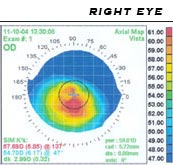
Photo from wikipedia
PURPOSE To evaluate a four-stage combined treatment for keratoconus including intrastromal corneal ring segment (ICRS) implantation followed by corneal cross-linking (CXL), toric phakic intraocular lens (IOL) implantation, and topography-guided photorefractive… Click to show full abstract
PURPOSE To evaluate a four-stage combined treatment for keratoconus including intrastromal corneal ring segment (ICRS) implantation followed by corneal cross-linking (CXL), toric phakic intraocular lens (IOL) implantation, and topography-guided photorefractive keratectomy (TG-PRK). METHODS In this retrospective interventional case series, 11 eyes of 7 patients with progressive keratoconus were treated with a four-stage procedure including the following: Keraring ICRS (Mediphacos Ltda, Belo Horizonte, Brazil) implantation followed by CXL, phakic IOL implantation, and TG-PRK (minimum 6 months between each stage). Minimum follow-up was 12 months after TG-PRK. RESULTS Both mean uncorrected distance visual acuity and corrected distance visual acuity (CDVA) improved from 0.025 decimal (20/800 Snellen) and 0.093 decimal (20/215 Snellen) preoperatively to 0.68 decimal (20/30 Snellen) and 0.73 decimal (20/27 Snellen), respectively, after the combined treatment (P < .0001). Mean postoperative CDVA of 0.73 decimal (20/27 Snellen) was similar to preoperative contact lens CDVA of 0.72 decimal (20/28 Snellen). Mean manifest refraction spherical equivalent reduced from 16.78 ± 3.58 to 0.59 ± 0.89 diopters (P < .0001) and mean refractive astigmatism reduced from 5.16 ± 1.86 to 0.82 ± 0.28 diopters (P < .0001). CONCLUSIONS This four-stage procedure appears to be an effective and safe approach for corneal stabilization and improvement of functional vision in patients with keratoconus. Larger case series with a longer follow-up are required to thoroughly evaluate the efficacy, safety, and stability of this combined approach. [J Refract Surg. 2017;33(10):683-689.].
Journal Title: Journal of refractive surgery
Year Published: 2017
Link to full text (if available)
Share on Social Media: Sign Up to like & get
recommendations!